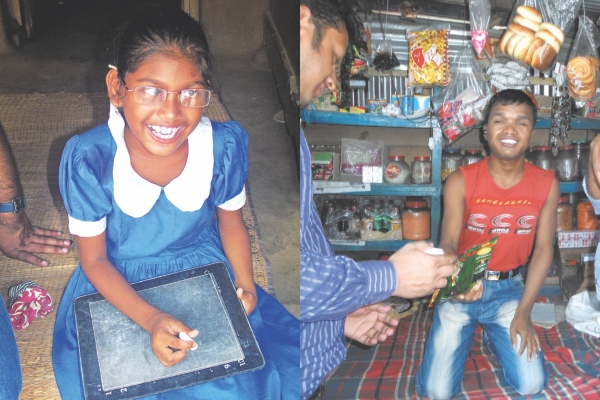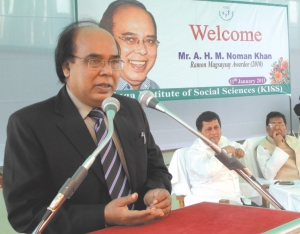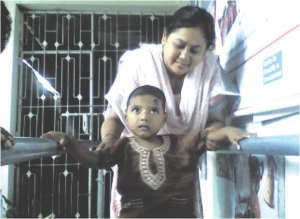| Home - Back Issues - The Team - Contact Us |
 |
| Volume 11 |Issue 03| January 20, 2012 | |
|
|
Endeavour A Brighter Future The Deafblind Story Osama Rahman Hafizul Rahman (Torikul) stands as a true testament of human will. A support staff of Jhikorgacha Development Organisation (JDO)in Jessore, Torikul goes about his daily menial tasks without the slightest hint of exerting extra effort. But what makes him such a prominent example of courage and self-belief? Unlike most, Torikul is not able to see, hear or even speak. Even the simplest of tasks for us is an arduous effort for him. Yet, when officials from Centre for Disability Development, one of the leading NGOs in the disability arena of Bangladesh, saw young Torikul dexterously chopping straws with a sharp knife, they immediately knew that he was capable of great things. After years and months of training and educating Torikul, the 21-year- old could finally be part of normal society. Given his penchant for following instructions and excellent functional skills, Torikul was offered a position at JDO and started drawing a monthly salary for his efforts, from the small grant allocation of the project. Recently married, Torikul has not only surpassed all the odds stacked against him, he has consequently also paved the path for many others like him to follow his footsteps. “Although I never thought of my disability as something to hold me back, even I could not imagine that one day I would be leading a perfectly normal life as now,” says a grateful Torikul. Torikul is only one of many examples, yet his story is one which greatly changes public perception of people with disability. Deafblindness is a combination of both hearing and vision loss in an individual and often appears with additional disabilities which result in complex problems in communication, mobility and other abilities. The condition results, slowly, in total withdrawal from society. The common concept is that these people can never lead ordinary lives. But thankfully, due to the effort of some dedicated organisations, this notion is now being put to bed.
Of all the disabled people in the world, 10 percent of the population reside in the developing world, a largely conservative estimate. According to a WHO estimate, around 10.7 percent of the disabled population suffer from multiple disabilities. Another independent disability survey revealed 1 lakh people from a roughly estimated population of disabled people in the country suffer from deafblindness. However, since deafblindness was not a recognised agenda, no initiative was taken to include this group of people into any programme specially tailored for them. Centre for Disability Development (CDD), identified that although, the requirement for a completely separate mechanism is not deemed to be compulsory, certain specifics needed to be considered nevertheless. Given the lack of distinction between the many different types of disabilities, shortage of skilled manpower and the presence of few organisations, which were either city-based or working on one particular disability, the deafblind population slowly receded into the shadows, donning the forcefully handed cloak of invisibility. AHM Noman Khan, recipient of the 2010 Roman Magsaysay award, considered to be Asia's Nobel Prize, started CDD in 1996 dealing in multiple sectors of disability. CDD undertook a large scale initiative to create mass awareness and created opportunities for this oft-overlooked segment of the population. Partnering with six different organisations, CDD began to develop a strong and supportive national infrastructure to aide the deafblind in attaining their rights. Research and Educative Action (READ), Dhaka, Bangladesh Organisation for Disabled Advancement (BODA), Kaligonj, Assistance for Blind Children (ABC), Narshingdi, Gram Bikash Sangstha (GBS), Bogra, Development Equality and Emancipation for Disadvantaged People in Bangladesh (DEED), Munshiganj and Jhikorgacha Development Organisation, Jessore, were all included as six partners in the programme. The creation of a National Resource Centre (NRC) on Deafblindess was set up in Dhaka. NRC has created 12 deafblind Field Educators (known as DFE) so far, who help those with disabilities for their development in day to day activities. So far, 348 deafblind have been properly identified and categorised. With the help of 16 partners, the project has aided in providing direct service to 213 of them while 171 have been receiving indirect service. Providing Technical and Financial Support as part of UKAid, Sense International India (SII) also set up the National Resource Centre to disseminate information and provide logistical support. By 2014, SII hopes to bring 800 deafblind children under their support system, providing a small but significant beacon of hope for many. Sherin Sultana, a DFE educator working with READ organisation, sees bright prospects in the development of this field, highlighting the case of 3-year-old Badhon. “When, he came to us, he was only two. He couldn't sit up on his own, let alone talk or show any decipherable movement. His mother was distraught.” After hearing about READ, his mother showed up at their Banani office. “He couldn't eat solid food, eat, speak or even stand up,” Badhon's mother informs. However, within six months of therapeutic and other services from the centre, Badhon began to sit up on his own. Within a year, he was able to call out to his mother, father and could stand up and walk around on his own. Now, Badhon has become a bundle of energy, highly inquisitive by nature and a fast learner. “My only wish was for him to stand up on his own. Now, I can actually think of sending him to school.” Badhon's mother states fondly, while Badhon is preoccupied with a toy car he has just got his hands on.
Rezwanur Rahman, another Deafblind Field Educator, mentions numerous other examples to show the success of the project. “The problem lies in the fact that all the blame falls on the mother in this situation. A mother is a best friend while also being the worst enemy for such children.” “Hence, the mother's role is pivotal to the development of the child or person in question,” continues Rezwanur. Rezwanur goes further to point out that no one can be completely visually impaired or hearing impaired and thus there is every possibility of rehabilitating the cases back into society. “We constantly talk to them, establish a connection and maintain it. If they have difficultly speaking, we help establish a connection with objects.” Rezwanur explains. “Glass signifies water or thirst, spoon means food and so on.” Improvement depends completely on the child; whilst some take a week to catch on other may take much longer, but recovery is possible. Abul Kalam Mamun is yet another example of the reward derived from intense will-power, determination and self-belief. Leading a normal life up till 5th standard, Mamum suddenly began to notice his surroundings getting darker. Visual impairment began to take place and soon he also started to lose his hearing ability. ABC, one of the partner organisations of NRC, identified him as a Deafblind. A cane and hearing aid were soon provided to him and he began to regain his confidence, once again willing to successfully integrate himself back into society. Finally, Mamun felt that he could leave the four corners of his home and head back into the world he once knew. On October 12, 2009, Sampada Shevde, the training manager of Sense International India, along with the Advocacy Officer of NRC went to visit the ABC field area. Mamun's history and tremendous energy led Sampada to inspire him to set up a small grocery shop, which was followed by a tea stall. Customers were amazed to see Mamun at work, complete self-dependent, aware of his surroundings, becoming another example for many. “ To be able to take care of myself and not having to rely on others is the greatest gift for me.” Mamun says, reflecting on times when he spent his days dependent and without the ability to socialise. “If you cannot see and hear, you just cannot speak. Therefore, the inability to speak is related to the other two factors.” Explains Sadaf Noori, co-ordinator of Deafblind Project, CDD. “Additional disabilities arise in the long term and thus each needs to be considered separately, hence the creation of Individual Education Plans (IEP).” Sadaf Noori identifies epilepsy and cerebral palsy, especially silent epilepsy, as especially detrimental to overall development, stating how each variation makes a case completely different from another. “It is obviously not a problem restricted to Dhaka City. We have 16 organisations working with us and 10 are in charge of identifying cases and bringing them to us,” Sadaf says. She also points out that although the Government is very helpful, but repetitive administrative changes acts as a major hindrance in the progress of projects. Sadaf Noori emphasises that deafblindness is not the end of the world and evidence shows that one suffering from it can be rehabilitated back to society, with only a little effort. “Sign language is another option. There is Braille, hand to hand sign language and hand over hand sign language. And the vocabulary isn't restricted to basic language but one can carry out extensively detailed conversations, just like a regular person,” Sadaf says. There remains, light at the end of the tunnel, and through the effort of these organsations, many lives are not only being touched, but rather being changed for the better. Deafblindness is a condition, but the numerous hindrances associated with it, are generally temporary ones. A little help, patience and tolerance can go a long way in helping the individuals feel part of society. Copyright
(R) thedailystar.net 2012 |
||||||||||||||


